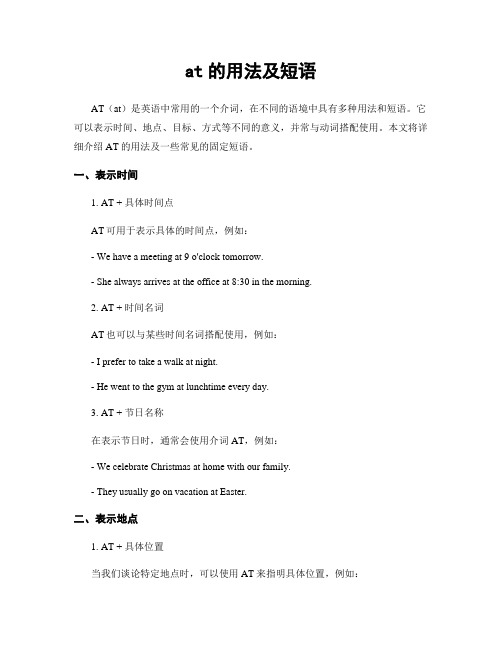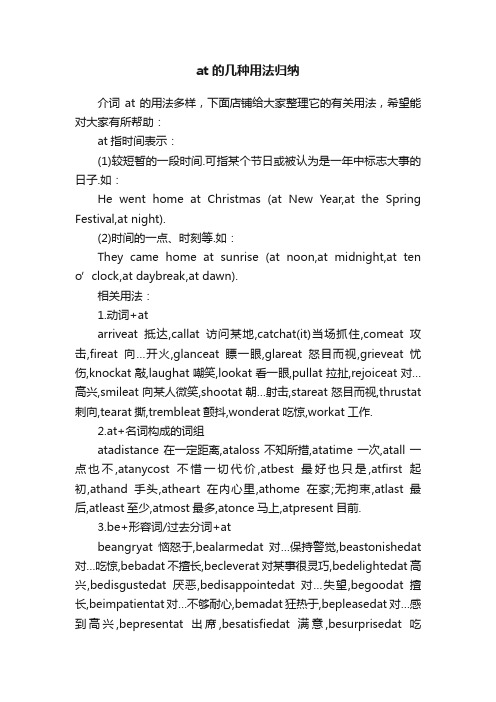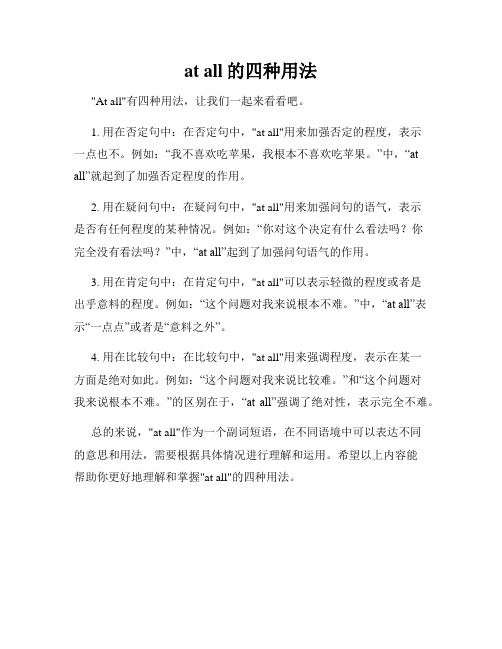at all的四种用法
atall的四种用法

atall的四种用法atall 是一个常见的英语词汇,它在不同的语境中有多种用法。
下面我们来详细了解一下 atall 的四种常见用法。
第一种用法:用于否定句,表示“根本;全然”。
例如:“I don't like coffee at all”(我根本不喜欢咖啡。
)在这个句子中,“notat all”的结构强调了完全否定的程度,意思是“一点也不”。
再比如:“He doesn't know the answer at all”(他根本不知道答案。
)这里同样用“at all”来加强“doesn't know”的否定程度。
当我们想要强烈地表达对某事或某物的否定态度时,使用“notat all”这种结构是非常有效的。
它让我们的语言更加生动、明确。
第二种用法:用于疑问句,表示“到底;究竟”。
比如说:“Did you sleep at all last night?”(你昨晚到底睡了没有?)这里的“at all”强调了对“是否睡了”这个问题的深究。
再看这个句子:“Why did you do that at all?”(你究竟为什么要那样做?)“at all”的存在使得疑问句更具探究和疑惑的语气。
这种用法通常用于我们想要获取更详细、更确切的信息,或者对某个出乎意料的行为或情况表示疑惑。
第三种用法:用于条件句,表示“既然;果真”。
举个例子:“If you do it at all, do it well”(既然你要做,就做好。
)在这个条件句中,“at all”表达了“既然”的意思,强调了在某种假设条件下的态度。
又如:“If you come at all, come early”(如果你真的来,就早点来。
)这里的“at all”传达了“果真”的含义。
这种用法体现了在特定条件下的期望或者要求。
第四种用法:用于肯定句,表示“真的;确实”。
例如:“It was a very difficult task, but she managed it at all”(这是一项非常困难的任务,但她确实完成了。
at的用法及短语 (2)

at的用法及短语AT(at)是英语中常用的一个介词,在不同的语境中具有多种用法和短语。
它可以表示时间、地点、目标、方式等不同的意义,并常与动词搭配使用。
本文将详细介绍AT的用法及一些常见的固定短语。
一、表示时间1. AT + 具体时间点AT可用于表示具体的时间点,例如:- We have a meeting at 9 o'clock tomorrow.- She always arrives at the office at 8:30 in the morning.2. AT + 时间名词AT也可以与某些时间名词搭配使用,例如:- I prefer to take a walk at night.- He went to the gym at lunchtime every day.3. AT + 节日名称在表示节日时,通常会使用介词AT,例如:- We celebrate Christmas at home with our family.- They usually go on vacation at Easter.二、表示地点1. AT + 具体位置当我们谈论特定地点时,可以使用AT来指明具体位置,例如:- She is waiting for you at the bus station.- The book is on the shelf at the bookstore.2. AT + 公共场所在描述公共场所时,通常可以使用介词AT,例如:- Let's meet at the cinema this evening.- They were having a picnic at the park yesterday.三、表示目标或对象1. GOOD AT / BAD AT"Good at"和"bad at"分别用来描述某人擅长或不擅长某项技能、能力等,例如:- She is very good at playing the piano.- I'm bad at remembering people's names.2. LOOK AT"Look at"用来表示看某人或某物,例如:- Look at that beautiful sunset!- Please look at the picture and tell me what you see.四、表示方式1. LAUGH AT"Laugh at"用来表示嘲笑或取笑某人,例如:- Don't laugh at her, she made a mistake.- It's not polite to laugh at other people's difficulties.2. SMILE AT"Smile at"表示微笑对待某人,例如:- The girl smiled sweetly at the stranger.- He always smiles at everyone he meets on the street.3. SHOUT/SREAM AT使用介词AT可以表达对某人喊叫、尖叫的方式,例如:- The angry teacher shouted at the students for being late.- She screamed loudly at the top of her lungs when she saw a spider.五、其他常见短语1. AT LEAST"At least"意为“至少”,可以用在比较中强调一个最低限度,例如:- You should study for at least two hours every day.- It will take us at least three days to finish this project.2. AT ALL"At all"意为“根本”,经常用于否定句和疑问句中,强调否定或怀疑的程度。
at的几种用法归纳

at的几种用法归纳介词at的用法多样,下面店铺给大家整理它的有关用法,希望能对大家有所帮助:at指时间表示:(1)较短暂的一段时间.可指某个节日或被认为是一年中标志大事的日子.如:He went home at Christmas (at New Year,at the Spring Festival,at night).(2)时间的一点、时刻等.如:They came home at sunrise (at noon,at midnight,at ten o’clock,at daybreak,at dawn).相关用法:1.动词+atarriveat抵达,callat访问某地,catchat(it)当场抓住,comeat攻击,fireat向…开火,glanceat瞟一眼,glareat怒目而视,grieveat忧伤,knockat敲,laughat嘲笑,lookat看一眼,pullat拉扯,rejoiceat对…高兴,smileat向某人微笑,shootat朝…射击,stareat怒目而视,thrustat 刺向,tearat撕,trembleat颤抖,wonderat吃惊,workat工作.2.at+名词构成的词组atadistance在一定距离,ataloss不知所措,atatime一次,atall一点也不,atanycost不惜一切代价,atbest最好也只是,atfirst起初,athand手头,atheart在内心里,athome在家;无拘束,atlast最后,atleast至少,atmost最多,atonce马上,atpresent目前.3.be+形容词/过去分词+atbeangryat恼怒于,bealarmedat对…保持警觉,beastonishedat 对…吃惊,bebadat不擅长,becleverat对某事很灵巧,bedelightedat高兴,bedisgustedat厌恶,bedisappointedat对…失望,begoodat擅长,beimpatientat对…不够耐心,bemadat狂热于,bepleasedat对…感到高兴,bepresentat出席,besatisfiedat满意,besurprisedat吃惊,beshockedat对…非常震惊,beterrifiedat受到…的恐吓,bequickat 对…很机敏.。
atall的四种用法

at all的四种用法一、用于否定句at all 用于否定句,主要是加强否定的语气,意思是:根本不,一点也不;如:It wasn’t difficult at all. 这一点也不难;There was nothing to eat at all. 根本没什么可吃的;That kind of belief is not at all unusual. 那种看法极为常见;I haven’t got any idea at all about what happened. 我根本不知道出了什么事;It’s quite extraordinary;I can’t understand it at all. 这件事太不寻常了,我根本没法理解;Mike doesn’t enjoy classical music very much at all. 迈克根本就不是很喜欢古典音乐;有时与hardly, few, seldom, scarcely 等半否定词连用;如:It hadly rained at all last summer. 去年夏天没怎么下雨;It scarcely mentions women at all. 它几乎一点都未提及妇女;注:在否定句中,at all 可位于句末,也可跟在否定词后;如:He’s not at all stupid. 他一点儿都不傻;He isn’t tired at all. /He’s not at all tired. 他一点也不累;另外,在口语中单独说not at all, 可用来回答感谢或道歉;如:A: Thank you very much. 多谢你了;B: Not at all. 不客气;A: I’m sorry to keep you waiting. 对不起,让你久等了;B: Oh, not at all. 噢,没关系;二、用于疑问句at all 用于疑问句,主要加强疑问的语气,意思是:到底,究竟,难道不;如:Did you know him at all 你究竟认识他还是不认识他Are you at all worried about it 你难道对此不担心吗Have you read any of the report at all 那份报告你到底有没有读一点Did it play any role at all in the presidential campaign&61472;这件事在总统选举中到底起作用没有三、用于条件句at all 用于条件句,主要用于加强if的语气,意为:假若,既然,即使,反正;如:If you do it at all, do it well. 既然要做,就把它做好;He’ll come before supper if he comes at all. 他要是来,准在晚饭以前;If you want to consult me at all, give me a ring. 如果你确实要和我商量,可以给我打个电话;四、用于肯定句at all 用于肯定句较少见,意为:不管怎样,竟然;如:I was surprised at his coming at all. 我很奇怪,他竟然来了;It’s a miracle that you returned at all. 你竟然回来了真是奇迹;That he was rescued at all was a matter of coincidences. 他的获救实属巧合;在肯定句中,尤其见于前面有any的场合,即用于强调any的意思;如:I’ll do any job at all—even road-sweeping. 什么工作我都干——扫街都行;You can come whenever you like---any time at all. 你什么时候想来就来——无论什么时候都行;。
at all的四种用法

最新最全的文档模板范本:At All 的四种用法本文将详细介绍 At All 的四种用法,并且提供相应的例句加深理解。
请子细阅读以下内容。
1. “At All”的表达全部的意思“At all”通常用于否定句中来表示“任何”的意思,它强调了“任何/全部”的概念。
例句:- I don't like oranges at all. (我一点也不喜欢橘子。
)- She's not interested in sports at all. (她一点也不喜欢运动。
)2. “At All”的表达最多的意思“At all”可以用来表示“最多/至多”的概念,通常用在肯定句中。
例句:- You can borrow my car for two weeks at all. (你可以最多借我的车两周。
)- The new restaurant can seat 50 people at all. (这家新餐厅最多可以容纳 50 人。
)3. “At All”的表达反问“At all”也可以用于反问句中,表示某事情非常显然对于问话人的意思非常重要。
例句:- You didn't like the movie at all? (你一点也不喜欢这部电影吗?)- You haven't seen her at all? (你一点也没见过她吗?)4. “At All”的表达总结性质“At all”还可以用来表示“总的来说/总的意思是”的概念。
例句:- The party was a success at all. (总的来说派对是成功的。
)- The meeting was a waste of time at all. (总的意思是这个会议浪费时间。
)本文档所涉及的简要注释如下:- At All - (英语短语)表示“全部/最多/反问/总结”等概念。
- 否定句 - 反表示肯定或者允许的语句。
- 肯定句 - 表示允许或者认可的语句。
at all的四种用法

at all的四种用法
"At all"有四种用法,让我们一起来看看吧。
1. 用在否定句中:在否定句中,"at all"用来加强否定的程度,表示
一点也不。
例如:“我不喜欢吃苹果,我根本不喜欢吃苹果。
”中,“at all”就起到了加强否定程度的作用。
2. 用在疑问句中:在疑问句中,"at all"用来加强问句的语气,表示
是否有任何程度的某种情况。
例如:“你对这个决定有什么看法吗?你
完全没有看法吗?”中,“at all”起到了加强问句语气的作用。
3. 用在肯定句中:在肯定句中,"at all"可以表示轻微的程度或者是
出乎意料的程度。
例如:“这个问题对我来说根本不难。
”中,“at all”表示“一点点”或者是“意料之外”。
4. 用在比较句中:在比较句中,"at all"用来强调程度,表示在某一
方面是绝对如此。
例如:“这个问题对我来说比较难。
”和“这个问题对
我来说根本不难。
”的区别在于,“at all”强调了绝对性,表示完全不难。
总的来说,"at all"作为一个副词短语,在不同语境中可以表达不同
的意思和用法,需要根据具体情况进行理解和运用。
希望以上内容能
帮助你更好地理解和掌握"at all"的四种用法。
atall的四种用法

atall的四种用法“atall”的四种用法在英语学习中,“at all”这个短语虽然看似简单,但却有着多种不同的用法,理解和掌握它们对于准确表达意思至关重要。
下面就让我们一起来详细探讨“at all”的四种常见用法。
一、用于否定句,加强否定语气当“at all”用于否定句时,它的作用是加强否定的程度,使否定的意思更加坚决和彻底。
例如:“I don't like this book at all”(我一点也不喜欢这本书。
)在这个句子中,“notat all”的组合让“不喜欢”的程度变得非常强烈,强调了完全没有喜欢的感觉。
再比如:“He didn't know the answer at all”(他根本不知道答案。
)“at all”的加入突出了“不知道”的完全性。
二、用于疑问句,表惊讶、怀疑等在疑问句中使用“at all”,往往能够表达出说话者的惊讶、怀疑或者难以相信的情绪。
例如:“Did you sleep at all last night?”(你昨晚到底睡了没有?)这里的“at all”传达出对对方是否有睡眠的怀疑和关切。
又如:“Can you help me at all?”(你到底能不能帮我?)此句中的“at all”体现了说话者对得到帮助的不确定性和急切想知道答案的心情。
三、用于条件句,表示强调在条件句中,“at all”用于强调某种条件的存在或重要性。
比如:“If you need my help at all, just call me”(如果你真的需要我的帮助,就打电话给我。
)这里“at all”强调了“需要帮助”这个条件的真实性和重要性。
再看这个例子:“I'll come if you ask me at all”(只要你叫我,我就来。
)“at all”突出了“叫我”这个条件的决定性。
四、用于肯定句,表“竟然、居然”在肯定句中,“at all”有时可以表示出乎意料或令人惊讶的情况。
介词at的用法总结 (2)

介词at的用法总结一、at表示时间点1. 表示具体时间:at 7 o'clock 在7点钟,at noon在中午2. 表示特定日子或日期:at Christmas 在圣诞节,at the weekend 在周末3. 表示较晚的时间点:at night 在夜晚,at midnight 在午夜二、at表示地点1. 表示具体位置:at school 在学校,at home 在家2. 表示建筑物或场所:at the cinema 在电影院,at a concert 在音乐会上3. 表示具体街道或地址:at 123 Main Street三、某些习语和固定搭配中使用介词 at1. at least 至少e.g. You should study for at least two hours every day.2. at first 起初e.g. At first, I wasn't sure if I wanted to go on the trip.3. at present 目前e.g. Our company is expanding rapidly at present.4. at times 有时候e.g. At times, I prefer reading books to watching movies.5. be good/bad at 擅长/不擅长某事e.g. I'm not very good at cooking.四、特殊用法1.at + 出席活动的动名词(-ing形式)e.g. Are you going to be at the meeting tomorrow?2.at + 助动词/情态动词 + 动词原形e.g. They are laughing at the joke.3.at it(做某事)e.g. He was working at it all night.4.at all(完全;根本)e.g. I don't understand him at all.5.be good at + 名词/动名词(-ing形式)e.g. She is good at playing piano.6.look at + 名词e.g. Please look at the picture carefully.总结:介词at在英语中主要用于表示时间点和地点。
- 1、下载文档前请自行甄别文档内容的完整性,平台不提供额外的编辑、内容补充、找答案等附加服务。
- 2、"仅部分预览"的文档,不可在线预览部分如存在完整性等问题,可反馈申请退款(可完整预览的文档不适用该条件!)。
- 3、如文档侵犯您的权益,请联系客服反馈,我们会尽快为您处理(人工客服工作时间:9:00-18:30)。
at all的四种用法
一、用于否定句
at all 用于否定句,主要是加强否定的语气,意思是:根本不,一点也不。
如:
It wasn’t difficult at all. 这一点也不难。
There was nothing to eat at all. 根本没什么可吃的。
That kind of belief is not at all unusual. 那种看法极为常见。
I haven’t got any idea at all about what happened. 我根本不知道出了什么事。
It’s quite extraordinary;I can’t understand it at all. 这件事太不寻常了,我根本没法理解。
Mike doesn’t enjoy classical music (very much) at all. 迈克根本就不(是很)喜欢古典音乐。
有时与hardly, few, seldom, scarcely 等半否定词连用。
如:
It hadly rained at all last summer. 去年夏天没怎么下雨。
It scarcely mentions women at all. 它几乎一点都未提及妇女。
注:在否定句中,at all 可位于句末,也可跟在否定词后。
如:
He’s not at all stupid. 他一点儿都不傻。
He isn’t tired at all. /He’s not at all tired. 他一点也不累。
另外,在口语中单独说not at all, 可用来回答感谢或道歉。
如:
A: Thank you very much. 多谢你了。
B: Not at all. 不客气。
A: I’m sorry to keep you waiting. 对不起,让你久等了。
B: Oh, not at all. 噢,没关系。
二、用于疑问句
at all 用于疑问句,主要加强疑问的语气,意思是:到底,究竟,难道不。
如:
Did you know him at all? 你究竟认识他还是不认识他?
Are you at all worried about it? 你难道对此不担心吗?
Have you read any of the report at all? 那份报告你到底有没有读一点?
Did it play any role at all in the presidential campaign?
这件事在总统选举中到底起作用没有?
三、用于条件句
at all 用于条件句,主要用于加强if的语气,意为:假若,既然,即使,反正。
如:If you do it at all, do it well. 既然要做,就把它做好。
He’ll come before supper if he comes at all. 他要是来,准在晚饭以前。
If you want to consult me at all, give me a ring. 如果你确实要和我商量,可以给我打个电话。
四、用于肯定句
at all 用于肯定句(较少见),意为:不管怎样,竟然。
如:
I was surprised at his coming at all. 我很奇怪,他竟然来了。
It’s a miracle that you returned at all. 你竟然回来了真是奇迹。
That he was rescued at all was a matter of coincidences. 他的获救实属巧合。
在肯定句中,尤其见于前面有any的场合,即用于强调any的意思。
如:
I’ll do any job at all—even road-sweeping. 什么工作我都干——扫街都行。
You can come whenever you like---any time at all. 你什么时候想来就来——无论什么时候都行。
